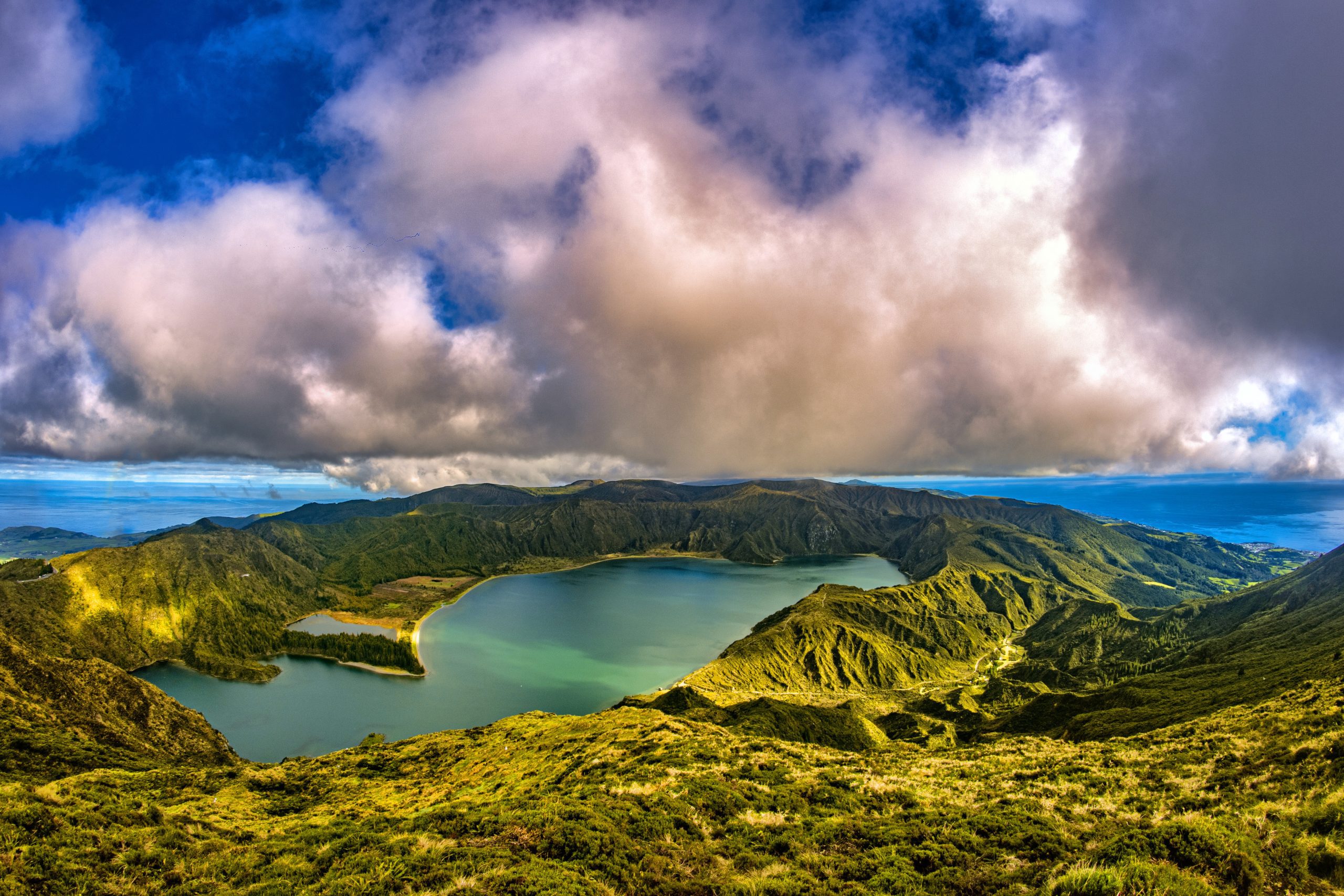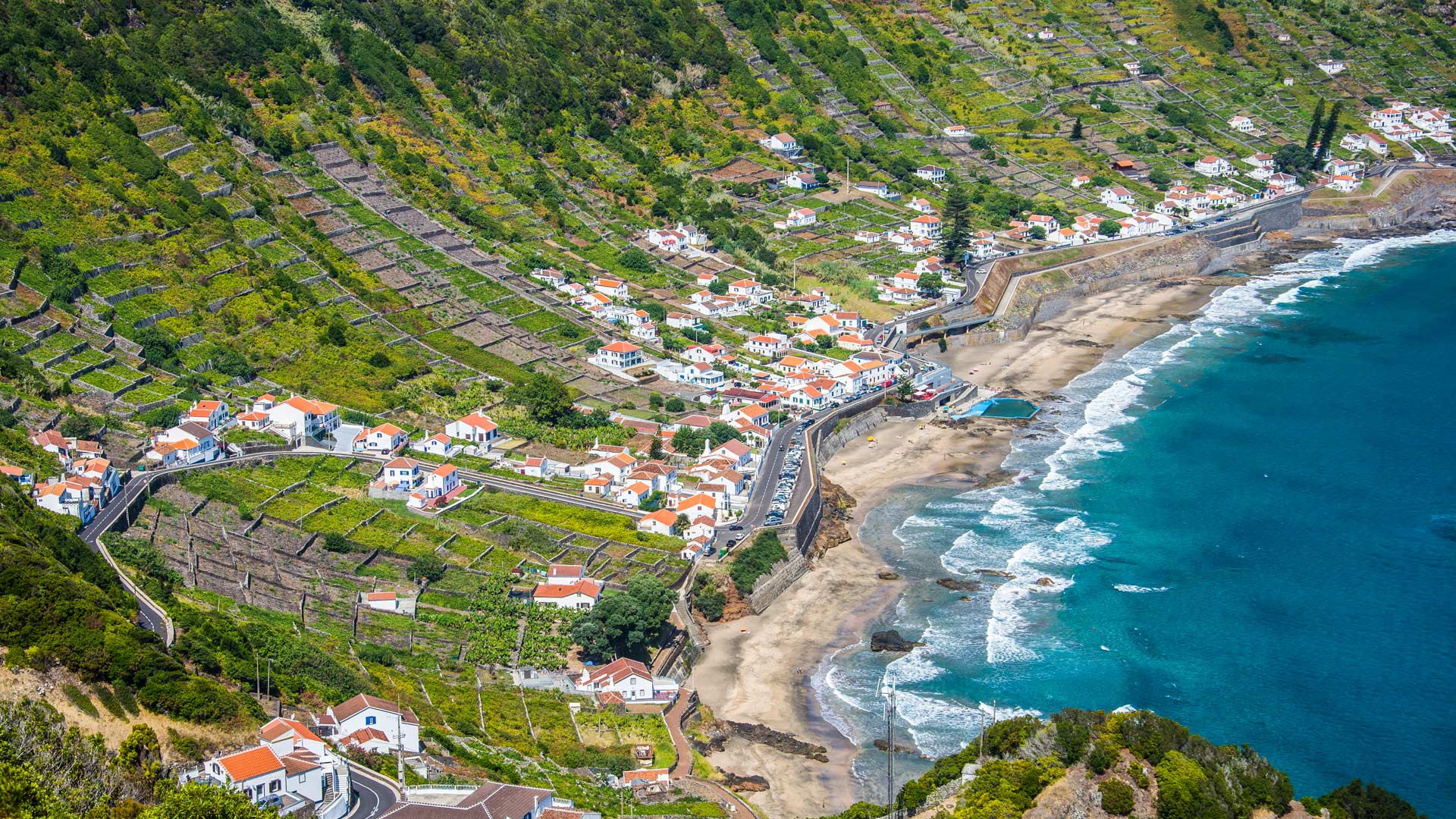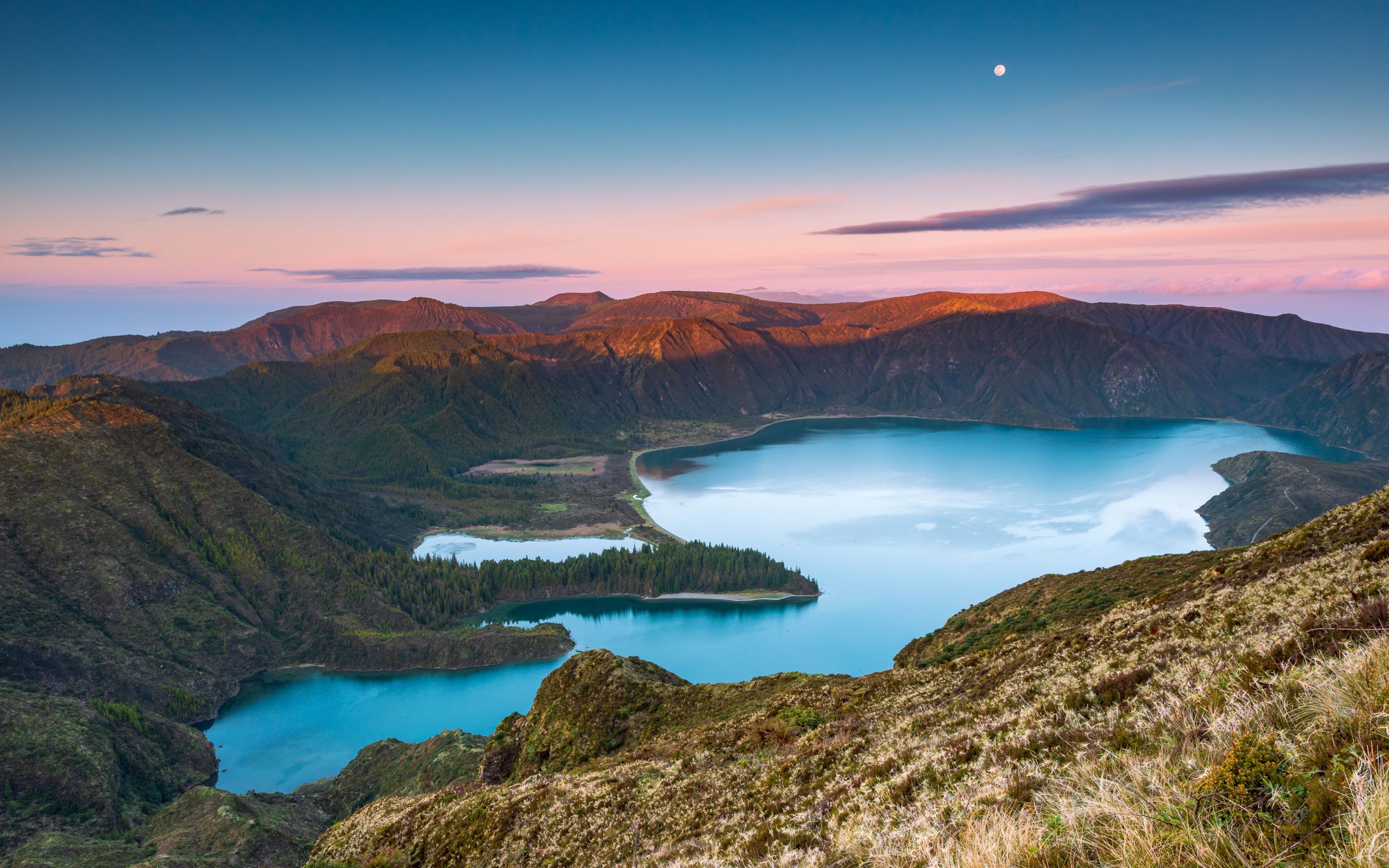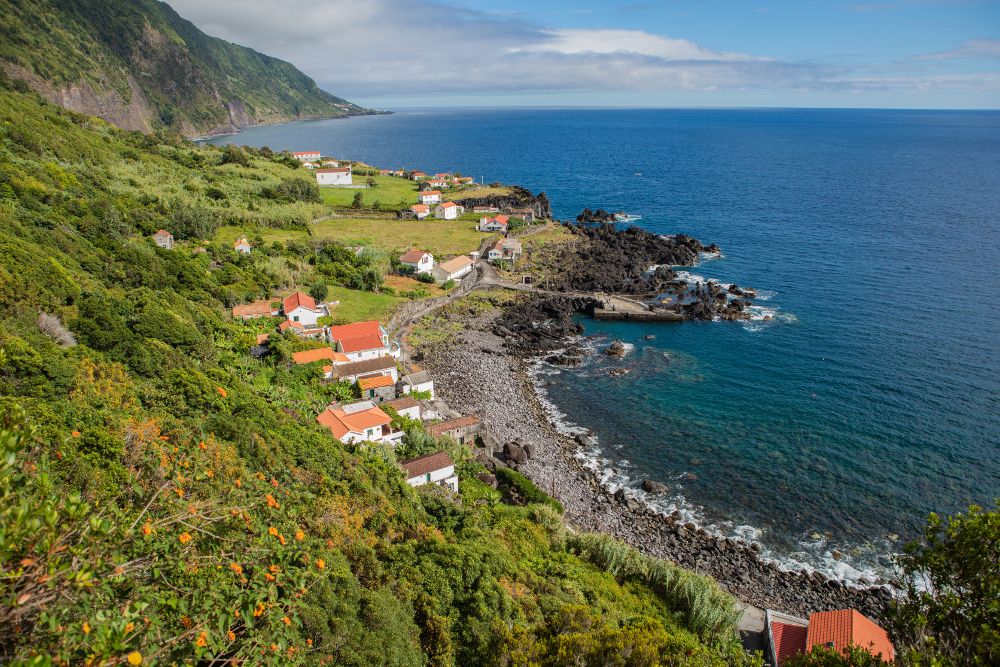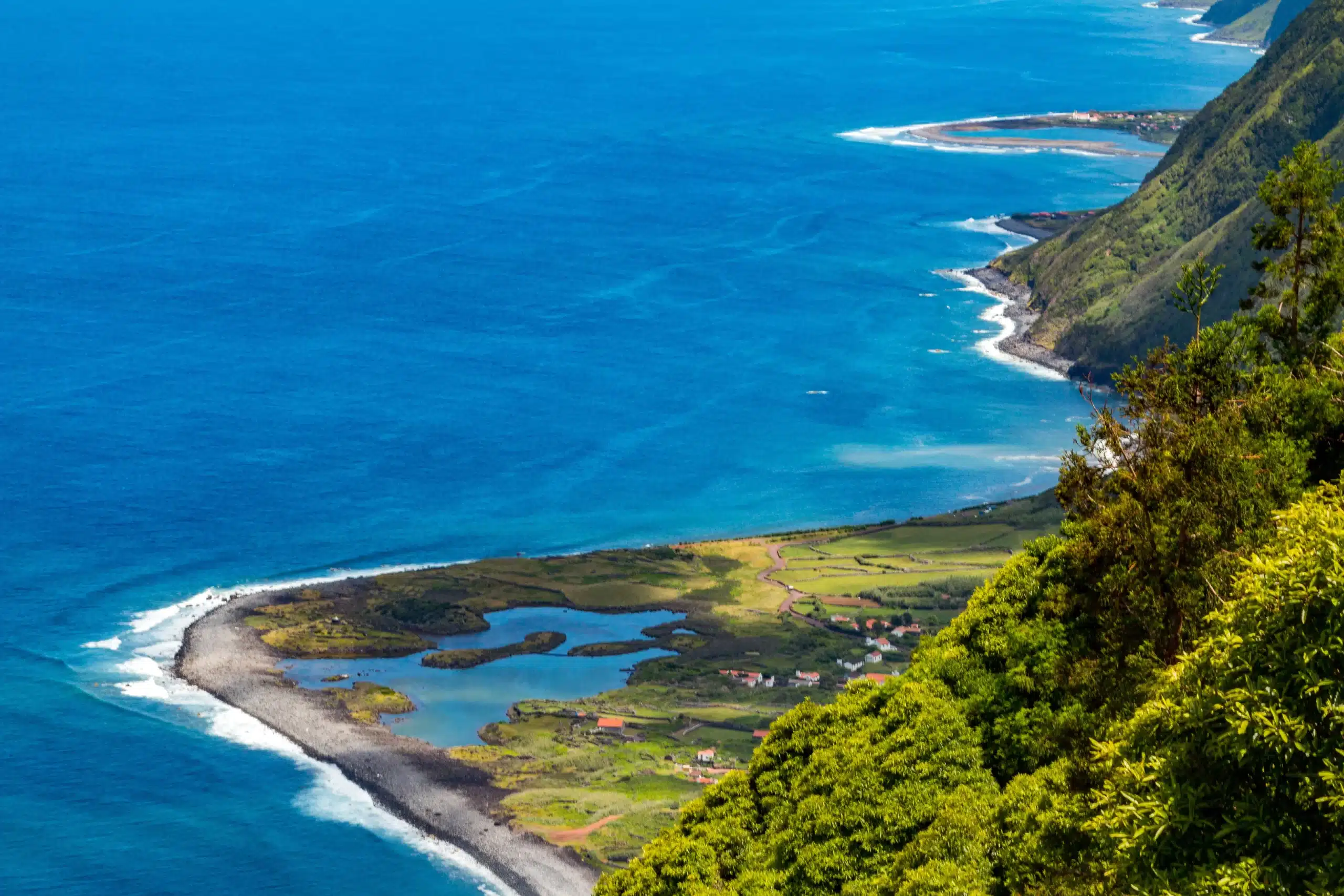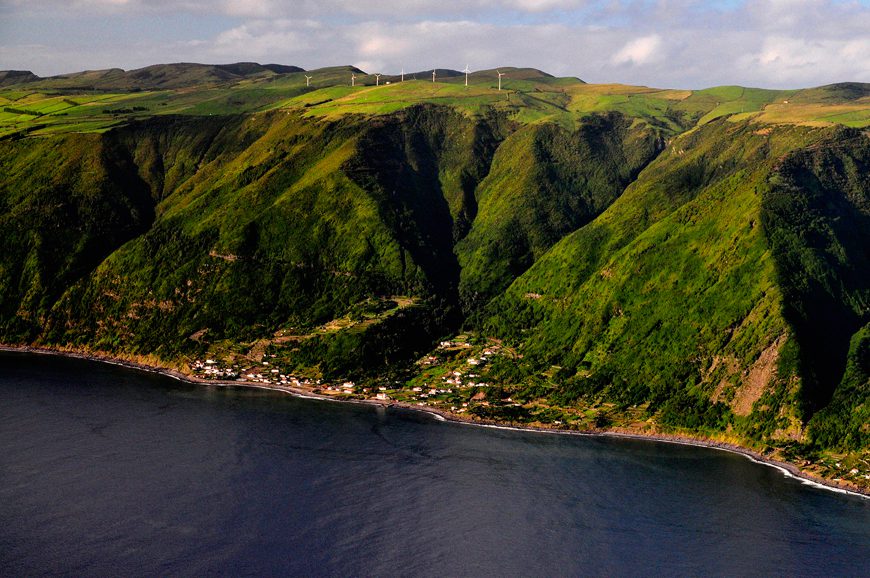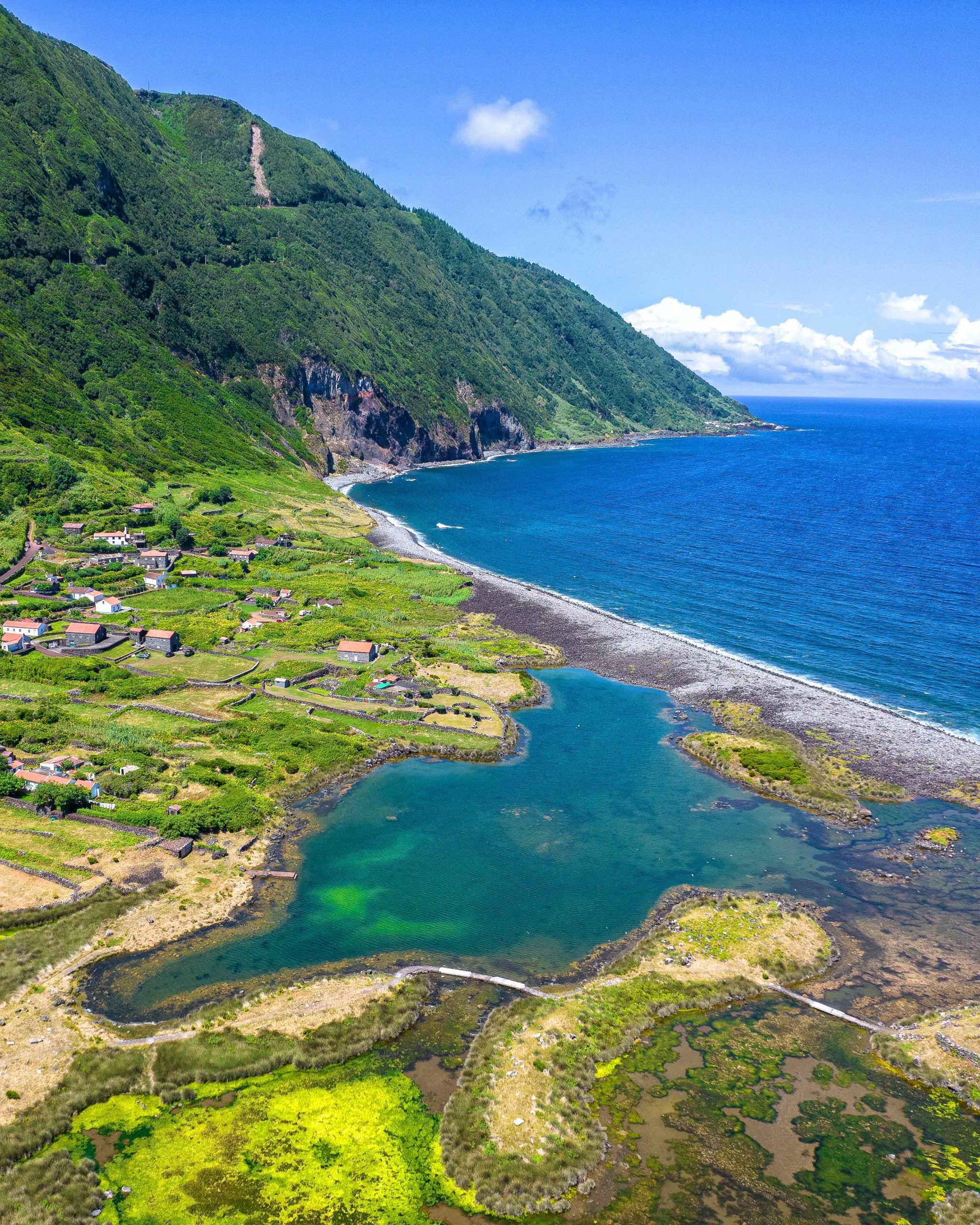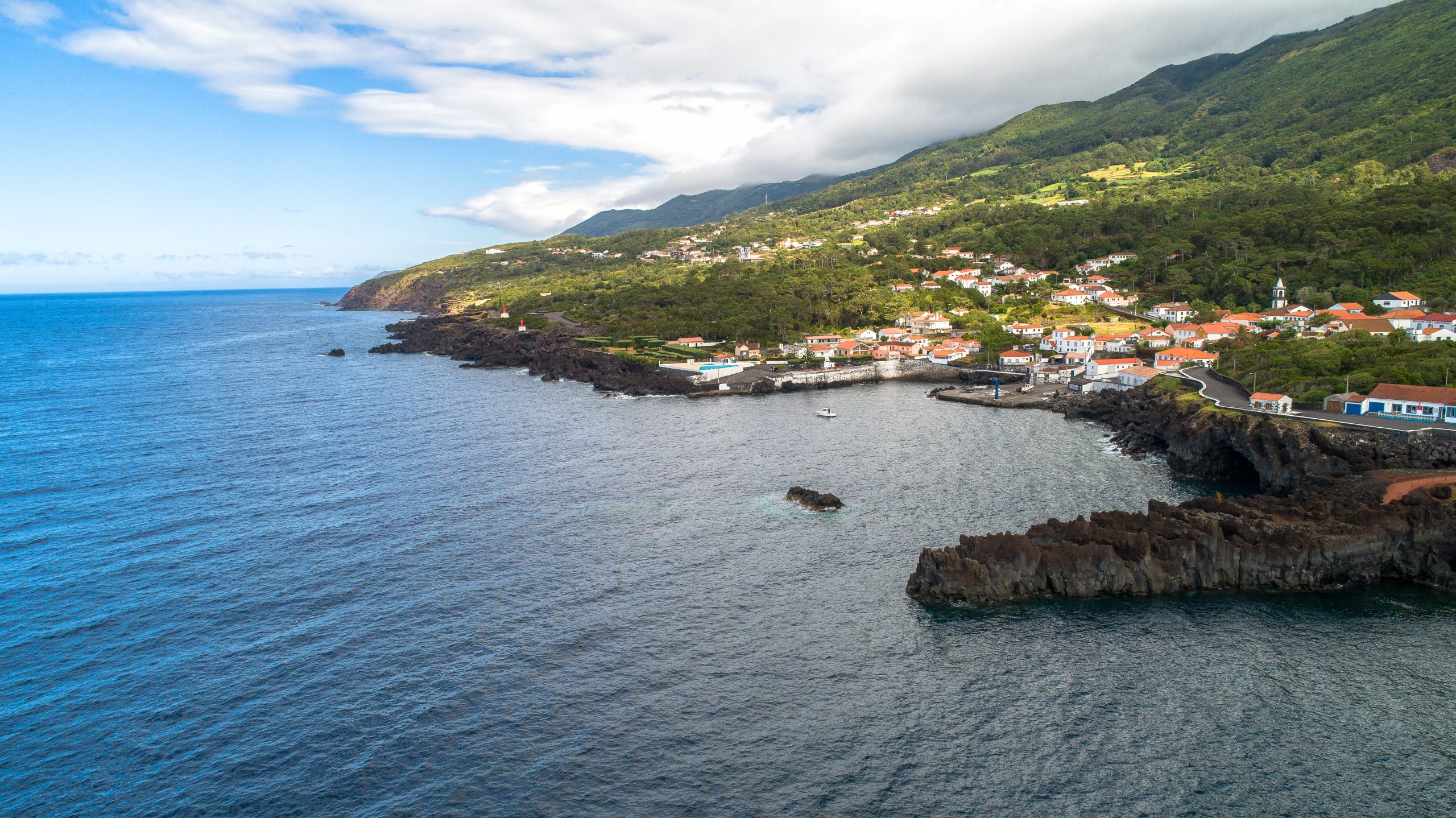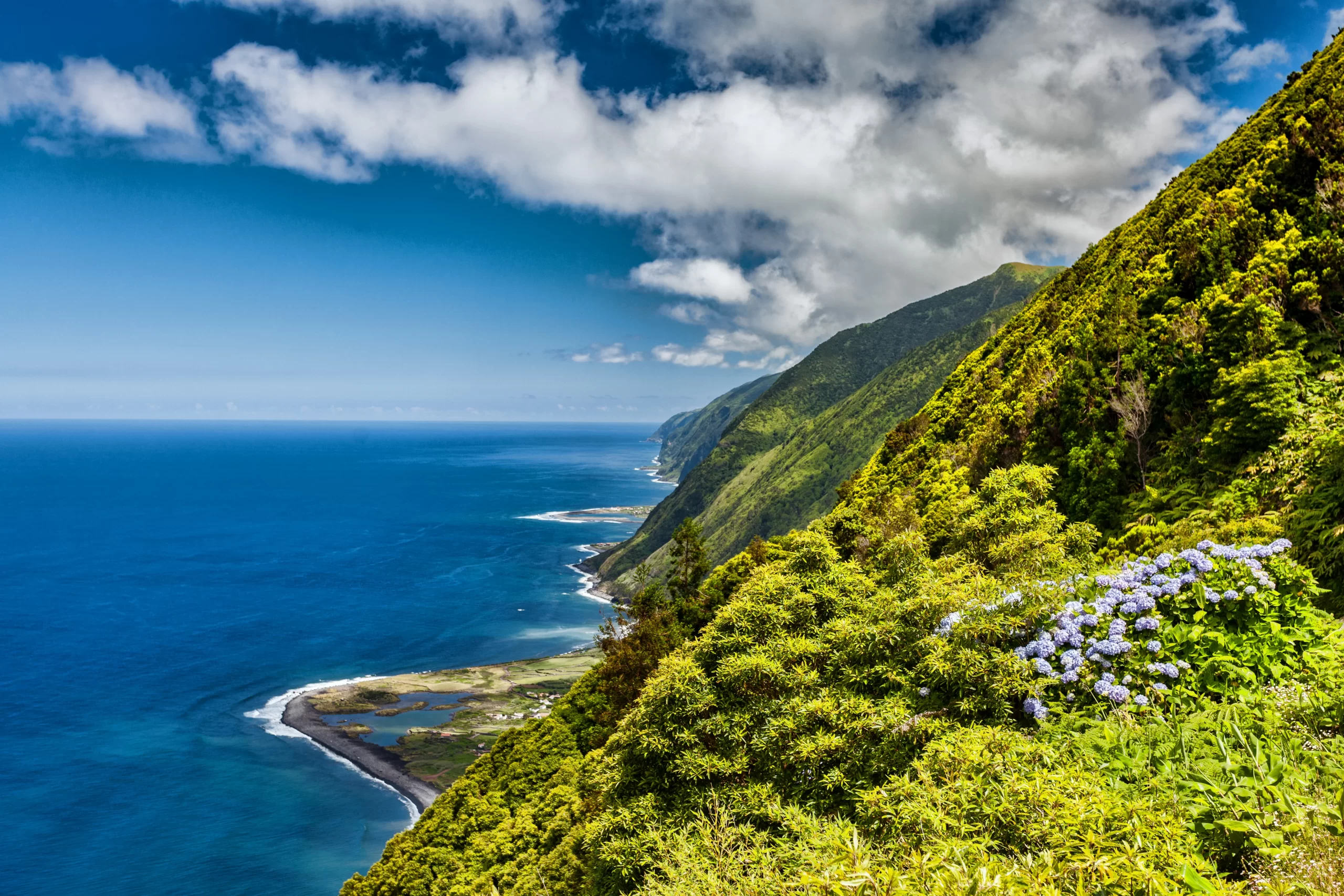Poça Simão Dias is a natural swimming pool located in Fajã do Ouvidor, one of the greatest fajãs of São Jorge’s North coast in the Azores. A fajã is a natural platform between the ocean and a cliff created by lava flows from volcanic eruptions or by landslides’ debris.
Poça do Simão Dias is one of the most emblematic natural swimming pools of the São Jorge island, thanks to its unique geological formations, and is considered by many as a real natural paradise for swimming and snorkeling. This is the largest pool and also one of the main attractions of the “dragon island”.
This is definitely a mandatory stop on your itinerary to São Jorge island, and in this complete guide, you will be convinced to explore it and have a swim in its crystal clear waters.
What is Poça Simão Dias

This U-shaped natural pool is the largest and most stunning on São Jorge, surrounded by basalt cliffs formed by ancient lava flows. Thanks to the unique form of the pool, it remains safe to swim most of the time, as the waves break on the lava stones around, protecting the swimmers while still allowing the water to renew. The lava cliffs are a testament to the island’s volcanic past: vertical basalt columns created as the lava cooled.
The contrast between the black of the basalt and the blue of the water is absolutely breathtaking. Poça do Simão Dias offers a delightful swimming experience in a protected area, while its biodiversity turns every dip into an underwater exploration. You can even see the basaltic columns underwater!
If you don’t want to swim, it is possible to observe this natural wonder from a viewpoint or walk to the pool to take amazing pictures.
Plan Your Visit to Poça Simão Dias

How to get to Poça Simão Dias
To reach Poça Simão Dias, drive to Fajã do Ouvidor, in the parish of Norte Grande, within the municipality of Velas. You can also grab a taxi. The journey ends at the small local harbor, where visitors must continue on foot along a stone path that leads to the pool.
The walk is moderate but rewarding, offering not only the destination itself but also stunning views of the coastline along the way, always surrounded by lava stones and lava flows.
Best Time to Visit
For the best experience, plan your visit during summer, when the water is warmer and the weather or sea conditions are more inviting. It can reach up to 24ºC!
Since the cliffs create shadows in the morning, it’s better to go later in the day, from noon, when the sun fully illuminates the pool, and you can lie down on the sun-absorbing black lava flows to work on your tan. Despite its increasing popularity, the area maintains a tranquil atmosphere, especially outside the peak holiday months of July and August.
Pro Tips

Aside from Simão Dias, Fajã do Ouvidor hosts other hidden gems like the Poça do Carneiro, right near Simão Dias. Take some time to explore the different paths around the natural pool to discover other great spots for a swim.
Whereas there are many snorkeling spots around the island, Poça do Simão Dias provides a unique experience, displaying both biological and geological wealth. This is one of the few places in the world where you can witness basaltic columns underwater.
Did you know
At Fajã do Ouvidor, during the high season, you will find a few cafés and a restaurant, offering visitors a place to relax post-swim.
For panoramic views, stop by the Miradouro da Fajã do Ouvidor. If you feel adventurous, you can consider hiking the Pico do Pedro to Fajã do Ouvidor trail (PR4SJO), which goes from the island’s highest peak, Pico da Esperança, down to the coast, for about 4 hours (17 km).
What To Do Around Poça Simão Dias
Miradouro da Fajã do Ouvidor

At the viewpoint, you can enjoy a panoramic view of Fajã do Ouvidor’s town, coast, and the surrounding cliffs. From up here, you can take beautiful pictures with both land and ocean at any time during the day.
The viewpoint is a great place to stop during your hike from Pico da Esperança to Fajã do Ouvidor and admire the view while catching your breath. You can also sit around and eat something before continuing the descent.
Hike the Trail From Pico do Pedro to Fajã do Ouvidor

This trail is not for people who don’t like to walk; it’s a 4-hour adventure. While it is only going down (we recommend walking the trail one way and then taking a taxi to reach your car at the starting point), it spans 17 kilometers with few shade spots.
Be sure to pack the necessary gear, including hiking shoes, a hat, sunscreen, water, a light jacket, comfortable clothing, and a rain jacket. In the Azores, you need to be prepared for any weather.
From Pico do Pedro, where you can park your car, you will walk up to the highest point of the island, Pico da Esperança, at 1053m above sea level. From there, it only goes down to sea level. It is definitely worth it, thanks to the jaw-dropping views on the island all along.
Visit the Tiny Village of Fajã dos Cubres

Dotted with traditional stone houses, Fajã dos Cubres is a perfect example of a typical fajã and is photogenic. Stroll in the narrow streets of this wonderful place in such an unlikely place. Don’t forget to visit the century-old church.
The houses fit perfectly in the landscapes. You will not find any buildings that are higher than two floors or big supermarkets. The high cliffs protect the village perfectly and open towards the ocean. It is a very peculiar way of life. To protect the inhabitants from the sea, you will see the natural protection all around: black pebbles. Everything about Fajã dos Cubres makes it a special place.
Surf at Fajã da Caldeira de Santo Cristo

It is a magical place! This nature reserve is considered a sanctuary for surf and bodyboard lovers. In this fajã, you can also go hiking or kayaking in the lagoon. In addition to the pure nature experience, the Fajã offers excellent cuisine.
Check all our articles about each one of the most relevant points of interest on São Jorge Island: Urzelina | Fajã do Ouvidor | Fajã de Santo Cristo | Fajã dos Cubres | Poça Simão Dias | Top Places to Visit in São Jorge Island | Miradouro Vigia da Baleia
Complementary Information
Best Season to Visit the Azores
The Azores Archipelago boasts a unique climate that shapes its lush landscapes, making it a splendid year-round destination. With mild temperatures and minimal fluctuations, each season offers something unique. Spring averages 16 °C, summer reaches 21 °C, autumn cools to 18 °C, and winter remains mild at 14 °C.
→ For a detailed breakdown of the weather by month, check the following links 🌤️☔️: January | February | March | April | May | June | July | August | September | October | November | December
How to Get to the Azores
The Azorean Archipelago is easily accessible through numerous flight routes. Lisbon and Porto are the main entry points to the continent, with direct flights available to São Miguel (PDL), Terceira (TER), Faial (HOR), Pico (PIX), and Santa Maria (SMA). To find the best flight, use search engines like eDreams or Skyscanner. These platforms enable you to compare prices and schedules from various airlines in one convenient location.
For more details on how to get to the Azores, take a look at our complete guide. But what if you want to explore beyond your arrival island? We’ve got you covered!
- Azores airports 🛬
- Flights between islands ✈️
- Ferries between islands ⛴️
- Which island to choose? 🏝️
- What airlines fly to the Azores? 🛩️
→ Once you’ve found the perfect route, book your tickets and get ready to experience one of the world’s most stunning island groups!
Travel Essentials
Essential Information for your Azores trip: Azorean Language & Phrases 🗣️ | Currency & Banks 💵 | Credit Cards & Traveler’s Cheques 🏧 | Driving in the Azores 🚗 | Electricity 🔌 | Experiences & Tours 🗺️ | Health & Safety 🩺 | Internet & Wi-Fi Access 🛜 | Phones & Mobile Service 📞 | Post Offices & Buying Stamps ✉️ | Public Holidays 🏖️ | Shopping 🛒 | Time & Daylight 🕒 | Whale Watching Guide 🐳 | Best Island to Visit 🏞️
Useful Tools & Apps
The weather in the Azores can be variable, so it’s helpful to use some apps before visiting the islands. Spotazores provides live camera feeds from the main tourist attractions, allowing you to check the weather and plan your visit. For accurate weather predictions, use Windy or Windguru — they provide the most reliable predictions.
Video
Conclusion
Visiting Simão Dias Natural Pool is more than a swim; it’s a beautiful experience of São Jorge’s raw beauty. With its mix of incredible geology, peaceful atmosphere, and pristine waters, it’s one of the unique natural attractions in the Azores archipelago.
The island of São Jorge itself is full of dramatic landscapes with towering cliffs and scenic fajãs, offering breathtaking scenery at every turn. But Poça do Simão Dias is not to be missed during your trip, whether you go for a swim or not. If you’re exploring the central group of islands in the Azores, Poça do Simão Dias is a destination that should top your list.
Authors’ Note
I am pleased to inform you that all the recommendations in this article are based on my personal experience and observations. As the author, I have personally visited each attraction mentioned, ensuring that every suggestion is grounded in first-hand knowledge and genuine enthusiasm.
FAQs
Poça Simão Dias is one of the most beautiful natural lava pools in the Azores, known for its crystal-clear water and volcanic rock formations. It’s located on the north coast of São Jorge Island, near the Fajã do Ouvidor.
Yes, it is generally safe to swim when the sea is calm. However, as it’s connected to the ocean, it’s essential to be cautious of strong waves or changing tides. Always check sea conditions before entering the water.
To reach Poça Simão Dias, drive or walk to the Fajã do Ouvidor and then follow a short walking trail along the coast. The access includes uneven rocky paths, so wear proper footwear.
The best time is during summer or on calm days with low tide. This ensures clearer water and safer swimming conditions, allowing you to enjoy this stunning natural spot fully.




